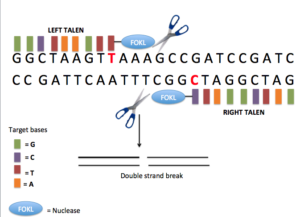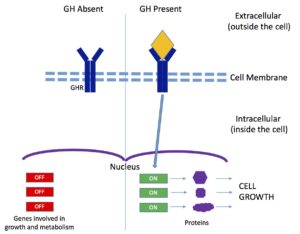Optional Section – Micropigs

Figure 1 General overview of the TALEN process. The left and right TALEN bind to a specific sequence of genomic DNA inside the nucleus of a cell. When they are correctly bound, nuclease enzymes (represented by scissors) cut the genomic DNA. The TALEN sequences can be edited by scientists to target different DNA sequences in the genome. (Photo credit: Ogletreerd, Wikimedia.
Growth hormone (GH) stimulates the growth of essentially all tissues within the body. GH is a 191 amino acid peptide (protein) hormone which is produced from the GH gene. Cells sense the presence of GH protein hormone with the growth hormone receptor (GHR) protein on the outside of the cell. GHR protein is produced from the GHR gene and is found on the cell membrane on the outside of cells.
The GHR protein has three major parts:
- An extracellular region that sticks out from the outside surface of the cell
- A transmembrane region that goes through the cell membrane and anchors the receptor to the membrane
- An intracellular region on the inside of the cell membrane that transmits signals to the interior of the cell.
The extracellular region binds (attaches) to GH, fitting together like a lock and its key. The binding of growth hormone transmits signals through the cell membrane to the intracellular region of the receptor (Figure 2). These signals “turn on” genes involved in growth and metabolism so that those genes are made into proteins. These proteins stimulate the growth and division of other cells in the organism.
If growth hormone is not present, the organism will not grow to full size. In humans, severe GH deficiency can lead to an adult height of only 4 feet tall. If growth hormone receptor is not present, the “grow” signal from the GH will not be transmitted inside of cells, so growth will not be stimulated (Figure 3).


References
Li f, Li Y, Liu H, Zhang H, Liu C, Zhang X, Dou H, Yang W, Du Y. 2014 Sep. Production of GHR double-allelic knockout Bama pig by TALENs and handmade cloning. Yi Chuan: 36(9):903-11.

